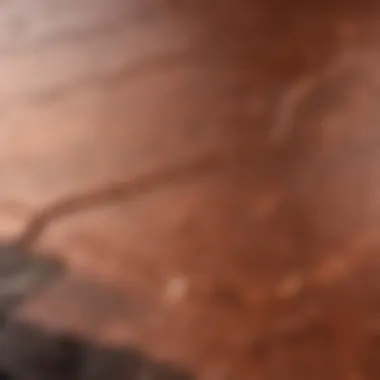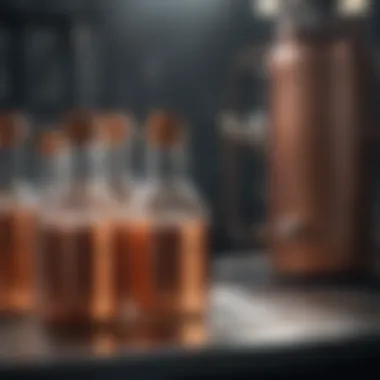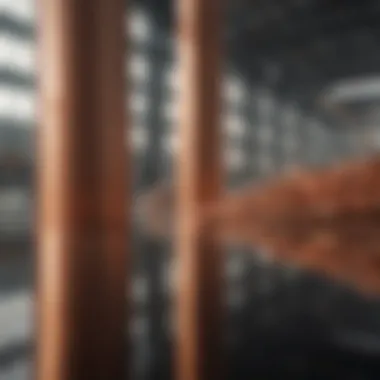Effective Strategies for Preventing Copper Oxidation


Intro
Copper is a metal of great utility, widely employed in various fields such as electrical engineering and artistic endeavors. This popularity arises from its excellent conductivity, malleability, and aesthetic appeal. However, one of the major challenges facing copper—particularly in outdoor or industrial environments—is oxidation. This chemical process not only affects the appearance of copper but can also compromise its functional properties. Thus, developing effective prevention strategies becomes pivotal.
In this article, we will explore a range of approaches to prevent copper oxidation. Sections will cover the fundamental causes behind this phenomenon, examine preventive methods, and assess innovative materials designed to extend copper's lifespan. By analyzing these strategies, we aim to furnish professionals and academics with a detailed resource for preserving copper's integrity over time.
Research Highlights
Key Findings
The main insights derived from our investigation include:
- Chemical factors: Understanding that copper readily reacts with oxygen, moisture, and contaminants in its environment is essential. This reaction leads to the formation of copper oxides, which can degrade both the metal’s appearance and functionality.
- Preventive measures: Employing chemical means such as protective coatings and physical barriers can effectively slow down or even prevent oxidation. Techniques vary based on the intended application and environment of the copper.
- Innovative materials: Recent developments in coatings specifically designed to offer long-term protection against oxidation have shown promise. These formulations not only resist environmental wear but may also possess self-healing properties.
- Maintenance protocols: Establishing proper maintenance schedules that include cleaning and inspection can mitigate the effects of corrosion. Regular upkeep ensures early detection of any deterioration, thereby prolonging the longevity of copper installations.
Implications and Applications
The implications of our findings extend across various domains:
- Electrical Industry: Ensuring the longevity of wiring and components reduces downtime and increases efficiency.
- Art and Design: Maintaining the aesthetic properties of decorative copper items influences consumer satisfaction and preserves cultural heritage.
- Manufacturing Processes: Implementing effective oxidation prevention strategies can enhance production efficiency and reduce costs associated with material failures.
Methodology Overview
Research Design
To extensively analyze the preventative measures against copper oxidation, we utilized both qualitative and quantitative research designs. A review of existing literature combined with laboratory experiments provided a solid foundation for our conclusions.
Experimental Procedures
Included in our analysis were:
- Sample Preparation: Different forms of copper were subjected to environmental simulations to observe oxidation rates under varying conditions.
- Treatment Application: Specific coatings and treatments were applied to assess their effectiveness in preventing oxidation.
- Data Collection: Utilizing advanced imaging techniques and chemical analysis, we tracked oxidation over time, allowing for a comparison between treated and untreated copper specimens.
By systematically approaching this topic, we aim to equip our audience with the necessary tools to understand and combat copper oxidation effectively. Through informed practices and innovative solutions, we can ensure copper remains a reliable material in many applications.
Preamble
Copper holds a significant place in modern society, given its diverse applicability across multiple sectors. From electrical wiring to decorative arts, the use of copper is prevalent due to its excellent conductivity and malleability. However, this metal is not without its challenges, particularly related to oxidation. This process not only affects the appearance of copper but can also compromise its functional properties over time. Therefore, understanding how to prevent copper oxidation is essential for preserving its integrity.
Oxidation occurs as a result of copper's interaction with environmental factors such as moisture and air, leading to the formation of copper oxide. The effects of this process can be detrimental, especially in electrical components where conductivity is critical. In many instances, oxidation can lead to failure of connections, causing cascading problems within systems. Therefore, addressing this issue holistically can have far-reaching benefits.
The discussion in this article will outline the fundamental principles behind copper's significance, delve into the mechanisms of oxidation, and present a range of preventive strategies. By understanding the implications of oxidation and the available measures for prevention, readers will be equipped with essential knowledge for effective copper preservation across various applications.
The Mechanism of Copper Oxidation
The mechanism of copper oxidation is a crucial aspect of understanding how to extend the lifespan of copper in various applications. This section provides insights into the chemical processes behind oxidation and the environmental factors that accelerate this deterioration. Understanding these components is vital for anyone involved in copper utilization, whether in electrical engineering, art, or construction. It helps in developing effective strategies to mitigate oxidation and preserve copper's integrity.
Chemical Reactions Involved
Copper oxidation primarily involves a reaction between copper and oxygen in the environment. When copper is exposed to air and moisture, it reacts to form copper oxide, commonly referred to as patina. The basic chemical reaction can be expressed as:


2Cu + O₂ → 2CuO
This reaction symbolizes the conversion of metallic copper into copper(II) oxide. The presence of acids, salts, or other corrosive agents can exacerbate this reaction, leading to faster deterioration of the copper surface. This aspect is especially crucial in environments that are humid or polluted, where the rate of oxidation significantly increases.
Key Points:
- Oxygen and moisture are primary catalysts in the oxidation process.
- The presence of contaminants can enhance corrosion rates.
- Accumulated copper oxides change the visual appearance of copper and can affect its properties.
Environmental Factors Contributing to Oxidation
Several environmental factors play a significant role in the oxidation of copper. These include:
- Humidity: High humidity levels facilitate the formation of moisture on copper surfaces, promoting oxidation reactions.
- Temperature: Elevated temperatures can accelerate chemical reactions, leading to faster oxidation rates.
- Pollutants: Elements such as sulfur dioxide or chlorine in the atmosphere can contribute to more aggressive forms of corrosion.
- Electrolytic Environment: In the presence of moisture, the formation of electrolytic cells can lead to galvanic corrosion, which compromises copper integrity even further.
Understanding these environmental implications allows for better strategic planning when it comes to copper preservation. By conducting environmental assessments, it is possible to identify the risks associated with various locales and tailor protective measures accordingly.
Important Note: The awareness of both chemical and environmental factors is essential in creating a comprehensive strategy for preventing copper oxidation. It enables stakeholders to take informed actions in preserving one of the world's most valuable metals.
Preventive Strategies: Overview
Copper oxidation is a crucial topic in both industrial and artistic contexts. Understanding how to effectively prevent this process can significantly extend the material's lifecycle. In this section, we will cover essential preventive strategies that can be employed. This overview provides clarity on how physical and chemical approaches complement each other, ensuring an efficient preservation of copper.
Physical vs. Chemical Prevention
When it comes to preventing copper oxidation, strategies can be broadly categorized into physical and chemical methods.
Physical Prevention involves creating barriers to limit exposure to oxidizing agents such as air and moisture. Common tactics include:
- Protective Films: Applying thin layers of polymeric materials that can shield copper from environmental elements.
- Metallic Barriers: Utilizing other metals to create a protective layer around copper objects can also be effective.
Chemical Prevention consists of using substances that actively inhibit the oxidation reaction. Some of the noteworthy approaches are:
- Anti-Oxidation Coatings: These coatings chemically bond with copper, providing a long-lasting protective effect.
- Corrosion Inhibitors: Special compounds added to the copper surface to prevent chemical reactions that lead to oxidation.
While both methods stand independently, their combination can often yield superior results. For example, a protective film may be used with anti-oxidation coatings to provide dual layers of defense against environmental degradation.
Importance of Regular Maintenance
Maintaining copper surfaces is as vital as the initial preventive measures. Regular maintenance can help acknowledge and resolve issues before they escalate. Here are some practices:
- Routine Inspection: Examine copper components periodically for signs of wear or oxidation. Prompt detection can prevent extensive damage.
- Cleaning Procedures: Regular cleaning with appropriate solutions ensures that oxidation-inducing dirt or residues do not accumulate on the surface.
- Reapplication of Treatments: Chemicals used in oxidation prevention, like coatings or inhibitors, may diminish over time. Their reapplication will safeguard copper against further corrosion.
Regular maintenance extends not only the lifespan of copper materials but also enhances their performance across various applications. By incorporating scheduled assessments into standard protocols, industries can achieve favorable outcomes.
In summary, understanding both physical and chemical preventive strategies alongside the importance of maintenance informs a comprehensive approach to sustaining copper integrity. The proactive management of these components ultimately ensures copper retains its valuable properties over extended periods.
Chemical Treatments for Copper
Copper, with its broad use in electrical applications and decorative arts, requires attention to the prevention of oxidation. Chemical treatments play a crucial role in preserving the integrity of copper objects. They act as protective barriers against environmental elements that contribute to oxidation, prolonging the lifespan of copper. These treatments can enhance aesthetic properties, electrical efficiency, and structural longevity. By understanding chemical treatments, we equip industries and professionals with essential tools to maintain copper in optimized conditions.


Anti-Oxidation Coatings
Types of Coatings
Anti-oxidation coatings serve to create a protective layer that limits copper's exposure to elements that can cause oxidative damage. Common types include organic coatings, such as acrylic and epoxy, and inorganic coatings, like aluminum oxide and ceramic-based options.
- Key Characteristic: The primary function of these coatings is to inhibit direct contact with oxygen and moisture.
- Benefit: They are favored for their ability to maintain the appearance while providing chemical resistance.
- Unique Feature: For instance, the ceramic-based coatings have high durability but can be brittle under certain mechanical stress.
Each type has its own set of advantages. For example, organic coatings are often easier to apply and rework. However, inorganic options may provide better resistance to high temperatures and harsh environments. Thus, understanding the specific applications will guide the choice of coating.
Application Methods
The application methods of anti-oxidation coatings determine the effectiveness and efficiency of the treatment. Common methods include spray application, brushing, and dipping. Each method comes with its own set of benefits and drawbacks.
- Key Characteristic: The choice of application largely impacts the uniformity and thickness of the coating.
- Benefit: Spray application, for instance, is often quicker and allows for a more even distribution over complex shapes.
- Unique Feature: However, brushing may give more control over thickness and is useful for touch-ups or detailed work.
Choosing the right method is essential for ensuring the protective qualities of the coatings are realized. It often depends on the specific conditions and desired outcomes in maintaining copper integrity.
Corrosion Inhibitors
Corrosion inhibitors are chemical substances added to prevent or reduce corrosion on copper surfaces. These agents function by altering the environment on the copper surface, creating a protective reaction that slows down the oxidation processes.
- Key Characteristics: They can be applied in a variety of forms, including liquid solutions and surface films.
- Benefits: Many corrosion inhibitors are highly effective in extending the life of copper components without significantly affecting their performance.
- Considerations: The selection of appropriate inhibitors depends on the specific application and environmental conditions. Some formulations may require careful handling to avoid adverse interactions with copper or other materials.
Physical Barriers Against Oxidation
Preventing copper oxidation is critical given its wide range of applications. Physical barriers play a vital role in this prevention. They serve to shield copper from environmental factors that contribute to oxidation, including moisture and pollutants. By implementing these barriers, one can significantly extend the life of copper and maintain its aesthetic qualities.
Protective Films
Protective films are essential in safeguarding copper against oxidation. These films provide a layer of protection that reduces direct exposure to environmental elements.
Polymeric Films
Polymeric films are a common choice for protecting copper surfaces. They are made of synthetic materials that can endure environmental stress. One key characteristic of polymeric films is their flexibility, which allows them to adapt to different shapes and surfaces without compromising adhesion. This property makes them a beneficial option because they can cover intricate designs found in artistic applications.
However, polymeric films have their downsides. They can be sensitive to UV radiation, which may degrade their integrity over time. Despite this disadvantage, their ease of application and protection against moisture make them a popular choice for various copper applications.
Metallic Barriers
Metallic barriers offer another effective method for preventing copper oxidation. These barriers are typically made from metals like aluminum or stainless steel. A key characteristic of metallic barriers is their ability to provide a robust shield against physical damage and environmental factors. Their durability makes them a beneficial choice for industrial applications where long-lasting performance is necessary.
Yet, metallic barriers can be more expensive than their polymeric counterparts. Additionally, they can add weight to the overall structure, which may not be suitable for all applications. Still, their unique feature of providing an almost impenetrable barrier makes them an excellent option for protecting valuable copper installations.
Environmental Control
Environmental control strategies are equally important in the physical prevention of copper oxidation. By managing the surrounding conditions, direct factors that lead to oxidation can be minimized. For instance, regulating humidity and temperature can significantly decrease the rate of oxidation.
Efforts to maintain these conditions might involve using dehumidifiers or air conditioners in enclosed spaces where copper is present. By controlling pollution levels, the exposure of copper to corrosive elements can also be significantly reduced.


Employing both protective films and environmental control together can itself form a comprehensive strategy for preventing copper oxidation and enhancing the longevity of copper applications.
Best Practices in Industries
The effectiveness of copper in various applications has made its preservation a priority across different sectors. Implementing best practices for preventing copper oxidation not only prolongs the life of copper components but also enhances performance, reliability, and safety. In industries that rely on copper, such as electrical engineering and decorative arts, a strategic approach to oxidation prevention is essential.
Electrical Applications
In electrical applications, copper is vital due to its excellent conductivity. To maintain this conductivity, several best practices are recommended:
- Use of High-Quality Materials: Selecting premium copper alloys can significantly reduce oxidation. Alloys designed for high-performance environments have better resistance to corrosion.
- Regular Inspection and Maintenance: Frequent checks for signs of oxidation are necessary. This includes inspecting connections, wires, and terminals.
- Utilization of Protective Coatings: Coatings specifically designed for electrical applications can offer protection against environmental factors. For instance, products like Permagard can shield copper from moisture and pollutants.
- Environmental Control: Keeping operating environments dry and free from harsh chemicals is crucial. Humidity and corrosive substances should be monitored to avoid oxidative conditions.
Art and Decoration
Copper's aesthetic appeal makes it a popular choice in art and decorative applications. However, exposure to air and moisture can tarnish its surface. Here are best practices for preserving copper in this field:
- Application of Protective Finishes: Clear varnishes or lacquers provide a barrier against air and moisture. Brands like Krylon offer specific products made for protecting copper art pieces.
- Storage Conditions: Proper storage is fundamental. Items should be kept in dry, low-humidity environments and away from direct sunlight to minimize tarnish.
- Cleaning Procedures: Gentle cleaning methods should be applied. Using a microfiber cloth with minimal abrasive substances can preserve the surface while removing dirt.
- Educating Clients and Users: Artists and restorers should inform collectors about maintenance. Providing guidelines on how to handle and care for copper pieces enhances long-term preservation efforts.
Implementing these practices not only helps in maintaining the aesthetics and functionality of copper but also ensures its longevity, especially in high-stakes environments.
Adhering to these best practices in both electrical and decorative applications ensures that copper maintains its integrity and continues to meet industry standards. The commitment to prevent oxidation translates to reduced costs due to less frequent replacements and repairs, further emphasizing the importance of strategy in handling copper.
Innovative Approaches to Preservation
Innovative approaches to preservation are fundamental in combatting copper oxidation. These strategies focus on new materials and technologies aimed at enhancing the longevity of copper. With copper being widely used in diverse fields like electronics and decorative arts, addressing its deterioration is crucial. Finding effective methods to prevent oxidation enhances copper's durability and maintains its aesthetic qualities.
Emerging Materials
Emerging materials play a significant role in the preservation of copper. These include advanced polymers and specialized coatings that resist oxidation. For instance, certain hybrid coatings exhibit remarkable adhesion and tarnish resistance. Materials such as titanium dioxide or silica nanoparticles are being integrated into coatings, helping to form a protective layer over copper surfaces.
Key benefits of using these materials include:
- Increased Longevity: Protective coatings can significantly extend the life of copper products by acting as barriers against corrosive elements.
- Aesthetic Appeal: Many emerging materials do not alter the visual appearance of copper, ensuring that its natural beauty is maintained.
- Environmental Resistance: Newer materials often offer better resistance to UV radiation and moisture, critical factors in oxidation.
Considering the adoption of emerging materials is essential for any industry relying on copper. It is important to evaluate technical specifications and possible limitations when selecting these materials. Depending on the application, factors such as temperature tolerance and flexibility of use may influence choices.
Technological Advancements
Technological advancements in preservation techniques contribute significantly to preventing copper oxidation. Techniques such as electrochemical deposition and surface modification have shown potential in creating robust barriers against environmental factors. These processes can alter the surface properties of copper, enhancing its resistance to corrosion.
Notable advancements include:
- Electrochemical Coating: This method allows for the precise application of protective layers, ensuring even coverage and reducing risk of oxidation spots.
- Nanotechnology: The use of nanomaterials can create extremely thin surface coatings that are high effective against oxidation without significantly adding weight or thickness to the copper piece.
Additionally, automation in the manufacturing process helps in applying these technologies consistently. The combination of innovative materials and technology provides a comprehensive solution to enhance the preservation of copper while optimizing production techniques.
"The marriage of cutting-edge technology and materials science offers formidable solutions in the ongoing battle against copper oxidation."
Ending
In this article, the examination of copper oxidation and the strategies to prevent it has shown itself to be a crucial endeavor for various sectors. Understanding the methods of preservation not only helps in maintaining the aesthetic qualities of copper but also in ensuring its functional longevity across diverse applications.
Summary of Key Points
Throughout the sections, we have explored several pivotal aspects. First, the fundamental cause of copper oxidation was established, emphasizing the impacts of environmental factors and chemical reactions. Next, we delved into both chemical and physical preventive measures, highlighting the distinctive roles of anti-oxidation coatings and protective films. Additionally, we discussed the importance of regular maintenance in preventing corrosion, which has ramifications in both industrial and decorative contexts. The review of best practices in different industries illustrated the adaptability of these strategies to specific needs. Finally, the investigation into innovative materials and technological advancements pointed towards a future where copper's integrity can be maintained more effectively than ever before.
Future Directions in Copper Preservation
Looking ahead, the field of copper preservation is poised for significant advancements. Emerging materials that promise better resistance to oxidation are on the forefront of research. For instance, nanotechnology may be employed to enhance coatings that protect copper while minimizing visual impact. Furthermore, the integration of smart technologies for monitoring the conditions surrounding copper installations can lead to more proactive maintenance strategies. Sustainability efforts are likely to drive the development of eco-friendly anti-corrosive treatments, which would benefit industry and environment alike. Ultimately, the synthesis of traditional methods with cutting-edge innovations will likely shape the effectiveness and efficiency of copper preservation strategies in the years to come.



